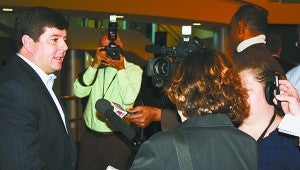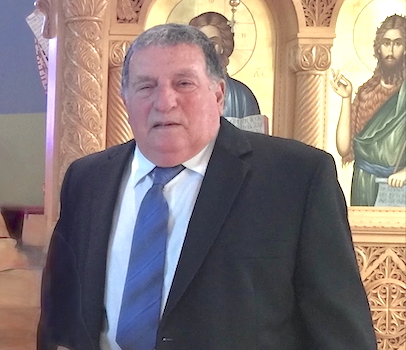Stennis Space Center briefs community leaders
Published 7:00 am Friday, February 14, 2014

Will Sullivan | Picayune Item
ADDRESSING REPORTERS: U.S. Rep. Steven Palazzo talks with local media representatives following the Stennis Space Center update at a breakfast for community leaders. He discussed the center’s importance to U.S. space exploration.
By Will Sullivan
Picayune Item
BAY ST. LOUIS — Stennis Space Center contributes nearly $1 billion to the economies of the Mississippi counties and Louisiana parishes around it, said center director Dr. Rich Gilbrech at a community breakfast briefing Thursday morning at the Infinity center for officials from those counties and parishes.
Gilbrech also discussed plans for the nation’s premier rocket engine testing center ranging from testing engines for the fledgling, but rapidly growing, commercial space industry, to the engines in the Space Launch System being tested for future NASA space exploration.
He said that in the near future a test of the Orion system launched from an airplane, and by 2021 exploration missions will begin. He noted that the test mission will orbit in the direction opposite of the Earth’s rotation because that will be needed for the mission to an asteroid. Normally, the space center director said, orbiting satellites and other systems orbit in the direction of the rotation of the Earth or other space body such as Mars.
Gilbrech also bragged a little, telling the assembled officials that Stennis Space Center has been honored as the best of the 10 NASA centers and has been honored as the second best place to work among federal agencies.
Prior to Gilbrech’s update, Rep. Steven Palazzo, R-4th Miss., told the group that he is anxious to return to having American astronauts launched from American soil. He said currently the United States is paying $70 million per seat for Russia to ferry the astronauts to the International Space Station.
He also told the group, “space exploration is important to the nation and not just for prestige and pride, … but also for national security. The congressmen said China and other nations have begun aggressively to set up space programs and this nation needs to stay in the lead.
Trending
After the briefing, while speaking to reporters, Palazzo said militarily, “we need to hold the high ground,” and today, “space is the high ground.”
He said when he explains it that way to other congressmen who are not sure we need a space program, they become more friendly to space exploration. He said he also explains the importance of the Stennis Space Center by pointing to the buffer zone, which is unique to Stennis, and explaining its purpose while testing rocket engines.
Palazzo and Gilbrech also pointed to the restricted air space over Stennis and buffer zone and how that restricted air space, especially as it is being expanded, is important to attract the testing and manufacture of “unmanned aerial vehicles” — drones — to the area in the future
Dr. Bill Burnett, deputy commander and technical director of the Naval Meteorology & Oceanography Command, said that agency is “thrilled to be a tenant at Stennis Space Center.” He said the U.S. Navy has an important impact on the local economy with its 2,000 employees and service members. Among future assets for the Navy at Stennis, he said the agency is getting new Cray computers that will place it back in the top 20 sites for super computing and he has hopes NAVOCEANO can move back into the top 10.
He said the agency’s importance in exploring oceans can’t be overstated.
“We want to bring home field advantage to our away games,” he said.
The U.S. Navy relies on its oceanographers and meteorologists to give its sailors the information about oceans and weather they need to fight wars, should that become necessary, he said.
Helmut Portman, director of the National Data Buoy Center, said that with about 100 contractors and about 50 employees, his agency is the smallest at the space center.
Also, within the National Oceanographic and Atmospheric Administration, “We’re sort of an anomaly in that we are not a research organization. We are an operational one,” Portman said.
He said his agency works closely with the National Weather Service to help predict weather through the buoys it places in oceans around the world. However, he said the agency is moving to “smaller packages” to gather the data.
“We are creating new ways to do ocean observations … (by) designing small, compact packages to place in the oceans.”
Portman also sounded the warning about China.
“Until the last decade, the United States had the lead in ocean observation,” he said. “Today, China and some other nations are aggressively” pursuing ocean observations, he said.
Portman also noted that his agency is proud of its part, with its buoys, in helping the National Weather Service predict hurricanes and other weather-related dangers to help save lives and property.





